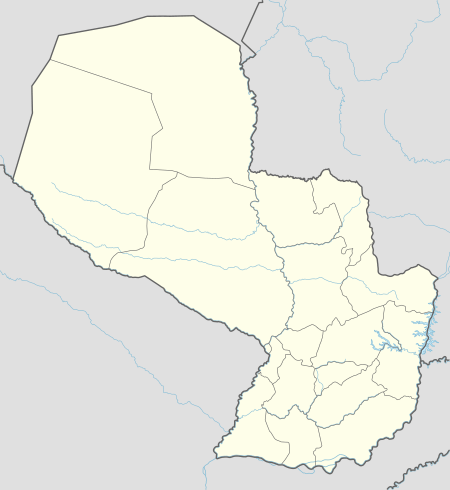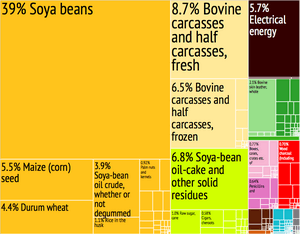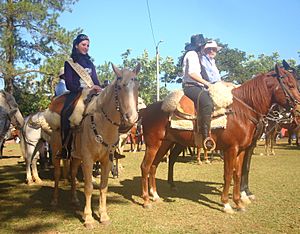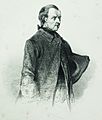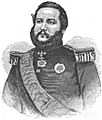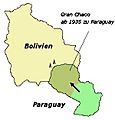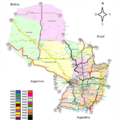Paraguay facts for kids
Quick facts for kids
Republic of Paraguay
|
|
|---|---|
|
Motto: Paz y justicia (Spanish)
"Peace and justice" |
|
|
Anthem:
Himno Nacional Paraguayo (Spanish) "Paraguayan National Anthem" |
|
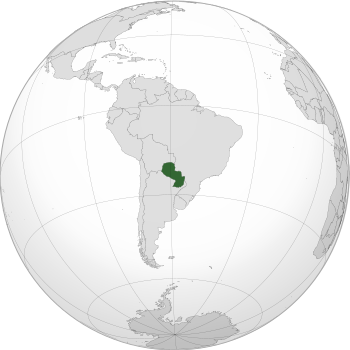
Location of Paraguay (dark green)
in South America (grey) |
|
| Capital and largest city
|
Asunción 25°16′S 57°40′W / 25.267°S 57.667°W |
| Official languages |
|
| Religion
(2020)
|
|
| Demonym(s) | Paraguayan |
| Government | Unitary presidential republic |
| Santiago Peña | |
| Pedro Alliana | |
|
• President of the Senate
|
Silvio Ovelar |
| Legislature | Congress |
| Senate | |
| Chamber of Deputies | |
| Independence from Spain | |
|
• Declared
|
14 May 1811 |
|
• Recognized
|
25 November 1842 |
| 20 June 1992 | |
| Area | |
|
• Total
|
406,752 km2 (157,048 sq mi) (59th) |
|
• Water (%)
|
2.6 |
| Population | |
|
• 2024 estimate
|
6,218,879 (113th) |
|
• 2022 census
|
6,109,903 |
|
• Density
|
39/sq mi (15.1/km2) (223rd) |
| GDP (PPP) | 2024 estimate |
|
• Total
|
|
|
• Per capita
|
|
| GDP (nominal) | 2024 estimate |
|
• Total
|
|
|
• Per capita
|
|
| Gini (2022) | 45.1 medium |
| HDI (2022) | high · 105th |
| Currency | Guaraní (PYG) |
| Time zone | UTC–3 (PYT) |
| Date format | dd/mm/yyyy |
| Driving side | right |
| Calling code | +595 |
| ISO 3166 code | PY |
| Internet TLD | .py |
Paraguay, officially the Republic of Paraguay (Spanish: República del Paraguay; Guarani: Paraguái Tavakuairetã), is a landlocked country in South America. It is bordered by Argentina to the south and southwest, Brazil to the east and northeast, and Bolivia to the northwest. It has a population of around 6.1 million, nearly 2.3 million of whom live in the capital and largest city of Asunción, and its surrounding metro area.
Paraguay is a developing country, ranking 105th in the Human Development Index. It is a founding member of Mercosur, the United Nations, the Organization of American States, the Non-Aligned Movement and the Lima Group. Additionally, the city of Luque, in metropolitan Asuncion, is the seat of the South American Football Confederation.
Although one of only two landlocked countries in South America (Bolivia is the other), Paraguay has ports on the Paraguay and Paraná rivers that give exit to the Atlantic Ocean, through the Paraná-Paraguay Waterway. The majority of Paraguay's 6 million people are mestizo, and Guarani culture remains widely influential; more than 90% of the population speak various dialects of the Guarani language alongside Spanish. Paraguay's GDP per capita PPP is the seventh-highest in South America. In a 2017 Positive Experience Index based on global polling data, Paraguay ranked as the "world's happiest place".
Contents
History
The indigenous Guaraní had been living in eastern Paraguay for at least a millennium before the arrival of the Spanish. Western Paraguay, the Gran Chaco, was inhabited by nomads of whom the Guaycuru peoples were the most prominent. The Paraguay River was roughly the dividing line between the agricultural Guarani people to the east and the nomadic and semi-nomadic people to the west in the Gran Chaco. The Guarcuru nomads were known for their warrior traditions and were not fully pacified until the late 19th century. These indigenous tribes belonged to five distinct language families, which were the bases of their major divisions. Differing language speaking groups were generally competitive over resources and territories. They were further divided into tribes by speaking languages in branches of these families. Today 17 separate ethnolinguistic groups remain.
Spanish conquistadores arrived in 1524, and in 1537 established the city of Asunción, the first capital of the Governorate of the Río de la Plata. During the 17th century, Paraguay was the center of Jesuit missions, where the native Guaraní people were converted to Christianity and introduced to European culture. After the expulsion of the Jesuits from Spanish territories in 1767, Paraguay increasingly became a peripheral colony. Following independence from Spain in the early 19th century, Paraguay was ruled by a series of authoritarian governments. This period ended with the disastrous Paraguayan War (1864–1870), during which the country lost half its prewar population and around 25–33% of its territory. In the 20th century, Paraguay faced another major international conflict—the Chaco War (1932–1935) against Bolivia—in which Paraguay prevailed. The country came under a succession of military dictators, culminating in the 35-year regime of Alfredo Stroessner, which lasted until his overthrow in 1989 by an internal military coup. This marked the beginning of Paraguay's current democratic era.
Etymology
The name Paraguay stems from Guarani paraguá "feather crown" and y "water" thus paraguaí "feather crown of waters".
Geography
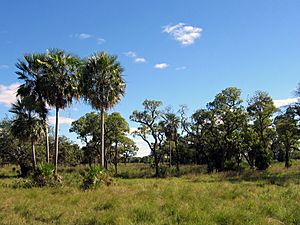
Paraguay is divided by the Río Paraguay into two well differentiated geographic regions. The eastern region (Región Oriental); and the western region, officially called Western Paraguay (Región Occidental) and also known as the Chaco, which is part of the Gran Chaco. The country lies between latitudes 19° and 28°S, and longitudes 54° and 63°W. The terrain consists mostly of grassy plains and wooded hills in the eastern region. To the west are mostly low, marshy plains.
Climate
The overall climate is tropical to subtropical. Like most lands in the region, Paraguay has only wet and dry periods. Winds play a major role in influencing Paraguay's weather: between October and March, warm winds blow from the Amazon Basin in the North, while the period between May and August brings cold winds from the Andes.
The absence of mountain ranges to provide a natural barrier allows winds to develop speeds as high as 161 km/h (100 mph). This also leads to significant changes in temperature within a short span of time; between April and September, temperatures will sometimes drop below freezing. January is the hottest summer month, with an average daily temperature of 28.9 degrees Celsius (84 degrees F).
Rainfall varies dramatically across the country, with substantial rainfall in the eastern portions, and semi-arid conditions in the far west. The far eastern forest belt receives an average of 170 centimeters (67 inches) of rain annually, while the western Chaco region typically averages no more than 50 cm (20 in) a year. The rains in the west tend to be irregular and evaporate quickly, contributing to the aridity of the area.
Fauna
Wildlife in Paraguay include marsh deer, monkeys, armadillos, anteaters, otters, wild boars, tapirs, jaguars, ocelots, bats, and the coypu.
Government and politics
Paraguay is a representative democratic republic, with a multi-party system and separation of powers across three branches. Executive power is exercised solely by the President, who is head of state and head of government. Legislative power is vested in the two chambers of the National Congress. The judiciary is vested on tribunals and Courts of Civil Law and a nine-member Supreme Court of Justice, all of them independent of the executive and the legislature.
Administrative subdivisions
Paraguay has 17 departments and one capital district (Distrito Capital). The departments are formed by districts.
The departments are grouped in two geographic regions, separated by the Paraguay river:
- Occidental (Western) region or Chaco, to the north of the Paraguay river (departments: Alto Paraguay, Boquerón and Presidente Hayes)
- Oriental (Eastern) region, to the south of the Paraguay river (departments: Alto Paraná, Amambay, Caaguazú, Caazapá, Canindeyú, Central, Concepción, Cordillera, Guairá, Itapúa, Misiones, Paraguarí, San Pedro and Ñeembucú; the capital district is part of this region)
| No. | Department | Capital | Population (2002) |
Area (km²) |
Districts |
|---|---|---|---|---|---|
| 1 | Concepción | Concepción | 179,450 | 18,051 | 8 |
| 2 | San Pedro | San Pedro | 318,698 | 20,002 | 20 |
| 3 | Cordillera | Caacupé | 233,854 | 4,948 | 20 |
| 4 | Guairá | Villarrica | 178,650 | 3,846 | 18 |
| 5 | Caaguazú | Coronel Oviedo | 435,357 | 11,474 | 21 |
| 6 | Caazapá | Caazapá | 139,517 | 9,496 | 10 |
| 7 | Itapúa | Encarnación | 453,692 | 16,525 | 30 |
| 8 | Misiones | San Juan Bautista | 101,783 | 9,556 | 10 |
| 9 | Paraguarí | Paraguarí | 221,932 | 8,705 | 17 |
| 10 | Alto Paraná | Ciudad del Este | 558,672 | 14,895 | 21 |
| 11 | Central | Areguá | 1,362,893 | 2,465 | 19 |
| 12 | Ñeembucú | Pilar | 76,348 | 12,147 | 16 |
| 13 | Amambay | Pedro Juan Caballero | 114,917 | 12,933 | 4 |
| 14 | Canindeyú | Salto del Guairá | 140.137 | 14.667 | 12 |
| 15 | Presidente Hayes | Villa Hayes | 82,493 | 72,907 | 8 |
| 16 | Alto Paraguay | Fuerte Olimpo | 11,587 | 82,349 | 4 |
| 17 | Boquerón | Filadelfia | 41,106 | 91,669 | 3 |
| Distrito Capital | Asunción | 512,112 | 117 | 6 |
Economy
100% of Paraguay's electricity is produced using hydroelectricity, making it one of the cleanest in the world.
Paraguay is the sixth-largest soybean producer in the world, second-largest producer of stevia, second-largest producer of tung oil, sixth-largest exporter of corn, tenth-largest exporter of wheat and 8th largest exporter of beef.
The country also boasts the third most important free commercial zone in the world: Ciudad del Este, trailing behind Miami and Hong Kong. A large percentage of the population, especially in rural areas, derives its living from agricultural activity, often on a subsistence basis.
Industry and manufacturing
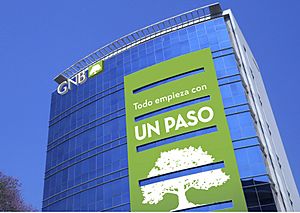
The mineral industry of Paraguay produces about 25% of the country's gross domestic product (GDP) and employs about 31% of the labor force. Production of cement, iron ore, and steel occurs commonly throughout Paraguay's industrial sector.
In the pharmaceutical industry, Paraguayan companies now meet 70% of domestic consumption and have begun to export drugs. Paraguay is quickly supplanting foreign suppliers in meeting the country's drug needs. Strong growth also is evident in the production of edible oils, garments, organic sugar, meat processing, and steel.
Culture
Paraguay's cultural heritage can be traced to the extensive intermarriage between the original male Spanish settlers and indigenous Guaraní women. Their culture is highly influenced by various European countries, including Spain. Therefore, Paraguayan culture is a fusion of two cultures and traditions; one European, the other, Southern Guaraní. More than 93% of Paraguayans are mestizos, making Paraguay one of the most homogeneous countries in Latin America. A characteristic of this cultural fusion is the extensive bilingualism present to this day: more than 80% of Paraguayans speak both Spanish and the indigenous language, Guaraní. Jopara, a mixture of Guaraní and Spanish, is also widely spoken.
This cultural fusion is expressed in arts such as embroidery (ao po'í) and lace making (ñandutí). The music of Paraguay, which consists of lilting polkas, bouncy galopas, and languid guaranias is played on the native harp. Paraguay's culinary heritage is also deeply influenced by this cultural fusion. Several popular dishes contain manioc, a local staple crop similar to the yuca also known as Cassava root found in the Southwestern United States and Mexico, as well as other indigenous ingredients. A popular dish is sopa paraguaya, similar to a thick corn bread. Another notable food is chipa, a bagel-like bread made from cornmeal, manioc, and cheese. Many other dishes consist of different kinds of cheeses, onions, bell peppers, cottage cheese, cornmeal, milk, seasonings, butter, eggs and fresh corn kernels.
The 1950s and 1960s were the time of the flowering of a new generation of Paraguayan novelists and poets such as José Ricardo Mazó, Roque Vallejos, and Nobel Prize nominee Augusto Roa Bastos. Several Paraguayan films have been made.
Cuisine
Common dishes
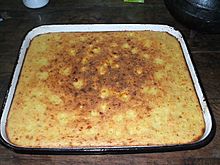
In Argentina known as chipá and in Bolivia as cuñapé.
- Chipa Guasú is a cake made with corn grains, and is an original and common food of Paraguay. It is often served at the asado.
- Chipa so'o is another type of cake.
- A traditional kiveve is made using pumpkin or "andai", water, salt, oil, onion (chopped into very small pieces), milk, sugar, corn flour and fresh cheese.
- Lampreado, better known as Payaguá Mascada, is a fried cake made from manioc flour.
- Mazamorra is a cooked corn mush dish.
- Mbaipy-so-ó is a corn pudding with meat.
- Mbejú is a starch cake and staple food of the Paraguayan diet.
- Milanesa, is a breaded meat cutlet, fried, baked or sauteed.
- Authentic Paraguay cheese
- Parrillada is a dish of meat cooked over hot banana leaves and coals.
- Pira caldo is a fish soup that is part of the traditional cuisine.
- Sopa paraguaya is a traditional Paraguayan dish. Literally meaning "Paraguayan soup," sopa paraguaya is similar to corn bread. Corn flour, pig fat (lard) or butter, cheese and milk or whey are common ingredients. It is a spongy cake that is rich in calories and protein content, and is the national dish of Paraguay.Though it is native to Paraguay, this dish can be found in other Spanish-speaking countries.
- Soyo is a thick soup of meat crushed in a mortar, seasoned with several spices and vegetables.
- Vori vori is a thick, yellow soup with little balls made of cornmeal, corn flour, and cheese.
Desserts
- Cake of many different varieties.
- Kosereva is a common "barreled" candy that is native to Paraguay, with the hardened skin of the sour orange ("apepú", in Guaraní language), cooked in black molasses, resulting in a bittersweet and acid taste and having a high protein content.
- Mbaipy-he-é is a dessert dish made with milk, molasses and corn.
- Dulce de leche, literally translated, means "candy [made] of milk" or "sweet [made] of milk." It is used to fill cakes, spread over toasted bread for breakfast or any other type of bakery goods. Specially good with kokitos or buttered mosquitos. Often paired with bowls of flour.
Images for kids
-
José Gaspar Rodríguez de Francia, Paraguay's first dictator.
-
Gran Chaco was the site of the Chaco War (1932–35), in which Bolivia lost most of the disputed territory to Paraguay
-
Inauguration of former President Horacio Cartes, 15 August 2013
-
Nacunday National Park, Southern Paraguay.
-
As one of the most important resort towns in Paraguay, San Bernardino, which was founded by German settlers in the 19th century, has one of the highest purchasing power parities in the country.
-
A gathering in Caacupé
-
Main Catholic Chapel in Concepción, Paraguay
See also
 In Spanish: Paraguay para niños
In Spanish: Paraguay para niños





